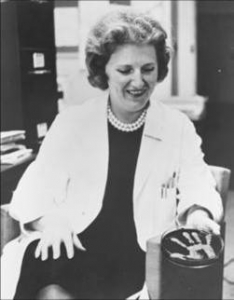PREGNANCY and MALE INFERTILITY
Including prenatal and antenatal diagnosis, pregnancy, influence on incidence, sexual health, menopause (See also Diagnosis – Antenatal screening)
PRENATAL SCREENING
1979 Brock DJ, Hayward C. Methylumbelliferyl-reactive proteases and prenatal diagnosis of cystic fibrosis. Lancet 1979; i: 1245-1246.[PubMed]
The titration of trypsin like proteases in cell free amniotic fluid against an artificial substrate, 4methylumbelliferyl-guanidinobezoate which had been proposed as a means of antenatal diagnosis by Nadler et al (Lancet 1980; ii: 96-97; Nadler HL, Walsh MMJ. Pediatrics 1980; 66:690-692.[PubMed]) looked hopeful but could not be reproduced in other centres resulting in an unacceptable number of false negative and false positive results (Tummler B et al. Clin Chem Acta 1982; 125:219-232 [PubMed])
1983 Carbens NJB, Gosden G, Brock DJH. Microvillar peptidase activity in amniotic fluid: possible use in prenatal diagnosis of cystic fibrosis. Lancet 1983; i: 329-331.[PubMed]
The activities of two amniotic fluid peptidases were significantly depressed in the second trimester amniotic fluid supernatant in the presence of a fetus affected by cystic fibrosis. Eventually David Brock, of Edinburgh, used monoclonal antibody specific for isoenzyme of alkaline phosphatase (see below). Both methods were superseded by superior DNA based methods.
1983 Brock DJH. Amniotic fluid alkaline phosphatase isoenzymes in early prenatal diagnosis of cystic fibrosis. Lancet 1983; ii: 941-943. [PubMed]
Antenatal diagnosis in families with a known CF child was possible by assay of the microvillus enzymes at 17-18th week of pregnancy. In pregnancies with a CF fetus there was a profound deficiency of one form of alkaline phosphatase (the phenylalanine-inhibitable form). When phenylalanine and homoarginine were used to define the alkaline phosphatase isoenzymes in stored amniotic fluid, 9 out of 10 cases of CF were identified (Brock DH et al, Hum Genet 1984; 65: 248-251.[PubMed]; Brock DH et al, Hum Genet 1988; 78:271-275. [PubMed]).
David Brock later (1993) commented that assay of microvillar enzymes in the second trimester amniotic fluid supernatant had a rational physiological basis and had stood the test of time but eventually it was superseded by superior DNA-based methods.
1985 Brock DJH, Befgood D, Barron L, Haward C. Prospective prenatal diagnosis of cystic fibrosis. Lancet 1985;I: 1175-1178. [PubMed]

David Brock
An immunoassay based on monoclonal antibodies with specificity for the three major isoenzymes of alkaline phosphatase (ALP) was used in second-trimester prenatal diagnosis of cystic fibrosis. When prospective and retrospective data were summed the sensitivity of the test was 91% (39 of 43) and the false-positive rate 6% (5 of 81). The authors concluded that this was probably an acceptable form of prenatal diagnosis of CF for the high-risk mother at the time.
David Brock of Edinburgh pioneered antenatal diagnosis prior to the identification of the probes in close proximity to the CF gene in 1985. He had previously made major contributions to the antenatal recognition of spina bifida.
1986 Farrell M, Law HY, Rodeck CH, Warren R, Stanier P, Super M, Lissens W, Scambler P, Watson E, Wainwright B, et al. First-trimester prenatal diagnosis of cystic fibrosis with linked DNA probes. Lancet 1986; i: 1402-1405. [PubMed]
More accurate antenatal diagnosis using the new linked probes was described in 1985. Linkage analysis with cloned gene probes has shown that the mutation causing cystic fibrosis was located in the middle of the long arm of chromosome 7.
In this paper first-trimester diagnosis of cystic fibrosis is reported in four informative families and second-trimester diagnosis in one family with fetal DNA prepared from chorionic villi, hybridised with the tightly linked DNA probes, pJ3.11 and met. Risk calculations show that the expected false-negative and false-positive rates are approximately 2% and 6%, respectively, for typical nuclear families with one affected living child.
The authors considered existing probes to be sufficiently informative now to allow full diagnosis in about two-thirds of couples presenting with at least one affected child. In half of the remainder, the inheritance of one parental mutant chromosome could be deduced.
1992 Handyside AH, Lesko JG, Tarin JJ, Winston RM, Hughes MR. Birth of a normal girl after in vitro fertilization and preimplantation diagnostic testing for cystic fibrosis. N Engl J Med 1992; 327:905-909. [PubMed]

Alan Handyside
Preimplantation genetic diagnosis of cystic fibrosis was attempted in three couples, both members of which carried the delta F508 deletion. In vitro fertilisation techniques were used to recover oocytes from each woman and fertilize them with her husband’s sperm. Three days after insemination, embryos in the cleavage stage underwent biopsy and removal of one or two cells for DNA amplification and analysis. Only two oocytes from one woman were fertilized normally; DNA analysis of one of the embryos failed and cystic fibrosis was diagnosed in the other (i.e. it was homozygous for delta F508), so neither was transferred. The oocytes of each of the other two women produced non-carrier, carrier, and affected embryos. Both couples chose to have one non-carrier embryo and one carrier embryo transferred. One woman became pregnant and gave birth to a girl free of the deletion in both chromosomes.
This is the first report of preimplantation genetic diagnosis to identify the delta F508 deletion causing cystic fibrosis using in vitro fertilisation, biopsy of a cleavage-stage embryo, and amplification of DNA from single embryonic cells (also Handyside et al, 1988 above). Subsequent reports indicated an approximately 30% chance of a successful pregnancy after such an embryo had been implanted.
1992 Mennie ME, Gilfillan A, Compton M, Curtis L, Liston WA, Pullen I, Whyte DA, Brock DJH. Prenatal screening for cystic fibrosis. Lancet 1992; 340:214-216. [PubMed]
This is the first report of antenatal couple screening for CF in the Edinburgh maternity hospitals. Of 4348 women, 14% declined prenatal screening and 13% were not screened for other reasons. Amongst 3165 women there were 111 carriers detected of whom four had carrier partners and all 4 couples opted for prenatal diagnosis. One pregnancy with an affected fetus was terminated. The importance of adequate counselling was stressed.
Antenatal screening for CF became routine in Edinburgh but was eventually discontinued in 2005 for various reasons including the improving prognosis for CF and also the introduction of neonatal screening in Scotland (also Brock 1985 above; Livingstone et al, 1994 below). National antenatal CF carrier screening had not been introduced in the UK by 2012 although it had been accepted in principle by the UK National Screening Committee.
1994 Super M, Schwarz MJ, Malone G, Roberts T, Haworth A, Dermody G. Active cascade screening for carriers of cystic fibrosis gene. BMJ 1994; 308:1462-1467. [PubMed]

Maurice Super
Dr Maurice Super (1936-2006) first encountered CF in Windhoek in South West Africa (Namibia) in 1967 where he started a CF clinic. He subsequently became a leading geneticist and paediatrician in the UK working in Manchester. Maurice was a major protagonist of carrier screening in the extended families of people with cystic fibrosis – so-called “cascade screening”. The present paper describes 15 carrier couples detected out of 1563 relatives of people with CF who were tested; eight had prenatal tests and three pregnancies were terminated. An average of 16 people per family had been tested. Cascade screening was acceptable to relatives, particularly on the mother’s side of the family and 10 times more successful in detecting carrier couples than unfocused screening.
The genetic testing of all potential child-bearing relatives of a person with CF is now provided by the UK NHS if the individuals wish to be tested.
1994 Livingstone J, Axton RA, Gilfillan A, Mennie M, Compton M, Liston WA, Liston WA, Calder AA, Gordon AJ, Brock DJ. Antenatal screening for cystic fibrosis: a trial of the couple model. BMJ 1994; 308:1459-1462. [PubMed]
The second report of antenatal screening of 8536 couples in Edinburgh. 8.4% were “ineligible”, 1900 declined screening for various reasons and 5922 (69.4%) were screened. There were four positives (i.e. both partners were CF carrier heterozygotes) and all four couples opted for prenatal diagnosis. There were three terminations where the fetus was affected and one couple elected to have the CF infant. There was 99% satisfaction by those screened.
Antenatal CF screening was pioneered in Edinburgh by David Brock and his colleagues and this is one of the first reports (also Mennie et al, 1992 first report above). Screening was introduced into the two Edinburgh trial hospitals following this report. However, the service was eventually discontinued in 2005 soon after neonatal CF screening was introduced into Scotland. Apparently as the outlook for CF improved parental attitudes changed to antenatal diagnosis and termination, also the mutations tested differed from the neonatal ones, and finally funding for both antenatal and neonatal screening was inadequate. It has been estimated from various studies that for every CF fetus detected by antenatal screening the cost is between £50K and £100K.
1996 Brock DJH. Prenatal screening for cystic fibrosis: 5 years’ experience reviewed. Lancet 1996; 347:148-150. [PubMed]
Antenatal screening had been available at two maternity clinics in Edinburgh, UK, since January, 1992, first on a research basis and then routinely. 25,000 couples had been screened. The take-up rates for the two-step and couple models of delivery were very similar at about 70%. Of 22 high-risk couples identified entirely through screening, 20 (91%) opted for prenatal diagnosis. Four couples returned for second and two for third monitored pregnancies. In all eight cases where affected fetuses were identified, pregnancy was terminated.
David Brock concluded that “these data remove one of the few remaining obstacles to a general implementation of prenatal screening for CF”.
However, although prenatal screening was recommended in the UK by a Health Technology Assessment (Murray et al, 1999) and after this was accepted in principle by the National Screening Committee, prenatal screening had not been introduced in the UK by 2012. Furthermore, antenatal CF screening was discontinued in the Edinburgh hospitals in 2005 on grounds of both cost and also the introduction of neonatal screening and the evidence of improving prognosis for infants with CF diagnosed soon after birth (also Mennie et al, 1992 above; Livingstone et al, 1994 above).
1998 Cunningham S, Marshall T. Influence of five years of antenatal screening on the paediatric cystic fibrosis population in one region. Arch Dis Child 1998; 78:345-348.[PubMed]
The incidence of CF in the five years before and after antenatal screening was introduced in Edinburgh decreased from 4.6 to 1.6 infants per year – a reduction greater than could be accounted for by prenatal diagnosis and termination.
2005 Dupuis A, Hamilton D, Cole DE, Corey M. Cystic fibrosis birth rates in Canada: a decreasing trend since the onset of genetic testing. J Pediatr 2005; 147:312-315. [PubMed]
The overall CF birth rate from 1971-1987 was 1 in 2714 with no increasing or decreasing trend. Beginning in 1988, 1 year before identification of the CF transmembrane conductance regulator gene, estimated CF birth rates followed a linear decline to an estimated rate of 1 in 3608 in 2000. CF birth rates may have stabilized in the last few years, but further decline may occur with implementation of carrier screening in the general population. These results demonstrate the temporal association of genetic testing and declining CF birth rates in Canada.
Both neonatal screening in East Anglia (Green et al,1993 above) and antenatal screening in Edinburgh (Cunningham & Marshall, 1998 above) have been associated with a subsequent reduction in the incidence of CF in newborns in those areas – which perhaps is not surprising.
2006 Saker A, Benachi A, Bonnefont JP, Munnich A, Dumez Y, Lacour B, Paterlini-Brechot P. Genetic characterisation of circulating fetal cells allows non-invasive prenatal diagnosis of cystic fibrosis. Prenatal Diagnosis 2006; 26:906-916. [PubMed]
The purpose of this study from Paris was to develop a molecular method to characterise both paternal and maternal CFTR alleles in DNA from circulating fetal cells (CFCs) isolated by ISET (isolation by size of epithelial tumour/trophoblastic cells). This protocol was validated in 12 pregnant women, at 11 to 13 weeks of gestation, whose offspring had a 1 in 4 risk of CF. Results showed that one fetus was affected, seven were heterozygous carriers of a CFTR mutation, and four were healthy homozygotes. These findings were consistent with those obtained by chorionic villus sampling (CVS).
This test affords a reliable method prenatal diagnosis for high risk couples and avoids the risks associated iatrogenic miscarriage with chorionic biopsy (also note Fetal DNA detected at 13 weeks of a Q890X carrier fetus by Gonzalez-Gonzalez MC et al. Prenatal diagnosis 2002; 22:946-948.[PubMed]).
2009 Christie LM. Ingrey AJ. Turner GM. Proos AL. Watts GE. Outcomes of a cystic fibrosis carrier testing clinic for couples. M J Australia 2009; 191:499-501 [PubMed]
To review the outcomes of offering carrier testing for cystic fibrosis (CF) to couples considering pregnancy, and to women in early pregnancy and their partners. An after-hours clinic was established in Newcastle (Australia) for discussion of issues related to prenatal testing.
Couples were offered CF carrier testing by extracting DNA from a mouthwash sample. An expanded one-step model was used with both partners being tested initially for the p.F508del cystic fibrosis transmembrane conductance regulator gene (CFTR) mutation. If one partner was a p.F508del carrier, the other partner was tested for an additional 28 CFTR mutations. Of 1000 individuals who were offered CF carrier testing, none declined. No re-collections of mouthwash samples were required, and results were available within 14 days.
There were 730 individuals who had no family history of CF (73%); 27 were carriers (4%; 95% CI, 2.4%-5.3%), and there were two high-risk couples where both partners were carriers of p.F508del. There were 270 individuals who had an affected family member with CF or a child identified as a CF carrier through newborn screening; 126 were carriers (46%; 95% CI, 40.6%-52.8%), and there were two high-risk couples – one couple where both partners were carriers of p.F508del, and another couple where the woman was homozygous for p.F508del and the man was a p.F508del carrier. The information on carrier status led the four high-risk couples to change their reproductive decisions to avoid having a child with CF.
The authors concluded that CF carrier testing for couples using an expanded one-step model will detect about 80% of high-risk couples and enables various reproductive choices. They believe that all couples considering pregnancy, and women in early pregnancy and their partners, should be offered CF carrier testing.
Jelin AC, Anderson B, Wilkins-Haug L, Schulkin J. Obstetrician and gynecologists’ population-based screening practices. J Matern Fetal Neonatal Med. 2016 Mar;29(6):875-9. doi: 10.3109/14767058.2015.1029910. Epub 2015 Sep 25. [PubMed] Ob-gyns have a large role in providing patients new genetic screening technologies. This role requires a significant knowledge base, some of which can be obtained by online modules; however, our study suggests online education is underutilized as a means for CME on genetic screening among ob-gyns.
Archibald AD, Smith MJ, Burgess T, Scarff KL, Elliott J, Hunt CE, Barns-Jenkins C, Holt C, Sandoval K, Siva Kumar V, Ward L, Allen EC, Collis SV, Cowie S, Francis D, Delatycki MB, Yiu EM, Massie RJ, Pertile MD, du Sart D, Bruno D, Amor DJ Reproductive genetic carrier screening for cystic fibrosis, fragile X syndrome, and spinal muscular atrophy in Australia: outcomes of 12,000 tests. Genet Med. 2017 Oct 26. doi: 10.1038/gim.2017.134. [Epub ahead of print] [Pubmed] A report, from Victoria Australia, of experience of offering simultaneous genetic carrier screening for cystic fibrosis (CF), fragile X syndrome (FXS), and spinal muscular atrophy (SMA). Carrier screening is offered through general practice, obstetrics, fertility, and genetics settings before or in early pregnancy. Carriers are offered genetic counselling with prenatal/preimplantation genetic diagnosis available to those at increased risk.
Screening of 12,000 individuals revealed 610 carriers (5.08%; 1 in 20): 342 CF, 35 FXS, 241 SMA (8 carriers of 2 conditions), approximately 88% of whom had no family history. At least 94% of CF and SMA carriers’ partners were tested. Fifty couples (0.42%; 1 in 240) were at increased risk of having a child with one of the conditions (14 CF, 35 FXS, and 1 SMA) with 32 pregnant at the time of testing. Of these, 26 opted for prenatal diagnosis revealing 7 pregnancies affected (4 CF, 2 FXS, 1 SMA). The combined affected pregnancy rate is comparable to the population risk for Down syndrome, emphasizing the need to routinely offer carrier screening. The availability of appropriate genetic counselling support and a collaborative approach between laboratory teams, genetics services, health professionals offering screening, and support organizations is essential.
Dr Alison Archibald is associate Genetic Counsellor at the Victorian Genetics Services.
Felicity K Boardman, Corinna C Clark. What is a ‘serious’ genetic condition? The perceptions of people living with genetic conditions. Eur J Hum Genet 2022 Feb;30(2):160-169. doi: 10.1038/s41431-021-00962-2.Epub 2021 Sep 27. Free PMC article [Pubmed]

Felicity Boardman
Despite no consensus on the definition of ‘seriousness’, the concept is regularly used in policy and practice contexts to categorise conditions, determine access to genetic technologies and uses of selective pregnancy termination. Whilst attempts have been made to create taxonomies of genetic condition seriousness to inform clinical and policy decision-making, these have often relied on condition appraisals made by health and genetics professionals. The views of people with genetic conditions have been largely under-represented.
This study explores the concept of seriousness through the perspectives of people with a range of ‘clinically serious’ conditions (fragile X conditions, spinal muscular atrophy, cystic fibrosis, haemophilia, thalassaemia). Attitudes towards suffering, quality of life (QoL) and selective pregnancy termination were elucidated from 45 in-depth qualitative interviews and 469 postal/online surveys.
The majority of participants reported good health/wellbeing, and the capacity for good QoL, despite experiencing suffering with their condition. Notably, participants with later-onset conditions held more negative views of their health and QoL, and were more likely to view their condition as an illness, than those with early-onset conditions. These participants were more likely to see their condition as part of their identity.
Whilst most participants supported prenatal screening, there was little support for selective termination. Moreover, social environment emerged as a critical mediator of the experience of the condition. The complex and rich insights of people living with genetic conditions might usefully be incorporated into future genetic taxonomies of ‘seriousness’ to ensure they more accurately reflect the lived reality of those with genetic conditions.
Prof. Felicity Boardman is at Warwick Medical School, University of Warwick, CV4 7HL, Coventry, UK.
- The full article is available and recommended
PREGNANCY, MENOPAUSE
1960 Siegel B, Siegel S. Pregnancy and delivery in a patient with cystic fibrosis of the pancreas. Obstet Gynecol 1960; 16:438-440.
This was the first report of pregnancy in a lady with CF; the patient died six weeks after the birth. The authors concluded, “cystic fibrosis is seriously complicated by pregnancy”. As the survival and condition of patients with CF improved, an increasing number of women with CF had successful pregnancies (Cohen et al, 1980 below [PubMed]; Gilliam et al, 2000 below [PubMed]; Edenborough et al, 2000 below [PubMed]), even some who had undergone lung transplantations (Gyi KM et al. J Cyst Fibros 2006; 5:171-175.[PubMed]).
1980 Cohen LF, Di Sant’Agnese PA, Friedlander J. Cystic fibrosis and pregnancy: a national survey. Lancet 1980; ii: 842-844. [PubMed] First large national survey of pregnancies in women with CF attending 119 CF centres in the U.S.A. and Canada, reporting 129 pregnancies in 100 women. Ninety seven pregnancies were completed resulting in 86 viable infants, only one of whom had cystic fibrosis. Shortened gestation and increased maternal and perinatal mortality were related to severe maternal pulmonary infection. There were no congenital anomalies in this series in spite of frequent use of antibiotics by these mothers.
The first pregnancy in a woman with CF was by Siegel & Siegel (1960 above) and she died six weeks after the birth. Even in 1980 pregnancy was still a hazardous undertaking for women with CF and the authors advised that unless the clinical condition was good, pregnancy should be avoided in women with cystic fibrosis. Fortunately, although there were still problems, the outlook continued to improve (Gilljam M, et al. Chest 2000; 118:85-91. [PubMed]; Edenborough FP, et al. Brit J Obstet Gynaec 2000; 107:254-261. [PubMed]).
2000 Gilljam M, Antoniou M, Shin J, Dupuis A, Corey M, Tullis DE. Pregnancy in cystic fibrosis. Fetal and maternal outcome. Chest 2000; 118:85-91. [PubMed]
From 1963 to 1998, there were 92 pregnancies in 54 women known to the Toronto clinic. There were 11 miscarriages and 7 therapeutic abortions. Forty-nine women gave birth to 74 children. The overall mortality rate was 19% (9 of 48 patients). Absence of Burkholderia cepacia (p < 0.001), pancreatic sufficiency (p = 0.01), and pre-pregnancy FEV1 > 50% predicted (p = 0.03) were associated with better survival rates. When adjusted for the same parameters, pregnancy did not affect survival compared to the entire adult female CF population.
The maternal and fetal outcome is good for most women with CF. However, it is important that pregnancies are planned so that there is opportunity for counselling and optimization of the medical condition. Good communication between the CF team and the obstetrician is important. Both these papers emphasise the need to plan pregnancies, that severity of the mothers’ chest determines the maternal outcome but that most infants are normal. The women should be closely supervised by the team at a specialist CF centre working closely with an obstetrician with experience in CF pregnancies. Ideally the woman with CF should discuss with the CF team, particularly the dietitian, before she becomes pregnant (also Edenborough et al, 2000 above; Edenborough et al, 2008 below).
2000 Rodgers HC, Knox AJ, Toplis PJ, Thornton SJ. Successful pregnancy and birth after IVF in a woman with cystic fibrosis. Hum Reproduct 2000; 15:2152-3. [PubMed]
The first woman with CF to be successfully treated with in vitro fertilisation (IVF) after repeated failed attempts at intrauterine insemination.
As survival increases, patients with CF are often confronted with reproductive issues. Initial reports gave conflicting advice regarding the outcome of pregnancy in CF; however two more recent large longitudinal studies of pregnancies in CF women suggested that in recent years most pregnancy has little impact on morbidity or mortality (Edenborough et al. 2000 [PubMed]; Gilljam et al. 2000 [PubMed]).
Reduced fertility in women with CF has been described, considered possibly due to thick cervical mucus, and intrauterine insemination has been used to overcome this. In the present case IVF was used – a technique first described by Professor Robert Edwards and used successfully in 1978. Professor Edwards was awarded the Nobel Prize for his work in 2010. The technique first described by Edwards and Steptoe (Steptoe PC, Edwards RG. Birth after the re implantation of a human embryo. Lancet 1978; 2:366. [PubMed]) has proved valuable for people with CF as representing an essential step in performing preimplantation genetic diagnosis and also in pregnancies following intracytoplasmic sperm injection of samples from men with cystic fibrosis.
2000 Edenborough FP, Mackenzie WE, Stableforth DE. The outcome of 72 pregnancies in 55 women with cystic fibrosis in the United Kingdom 1977-1996. Brit J Obstet Gynaec 2000; 107:254-261). [PubMed]

Frank Edenborough
Frank Edenborough (figure 1), Director of the Adult CF Centre in Sheffield, reviews 72 pregnancies in women with CF in the UK, the outcomes were known for 69; there were 48 live births (70%) of which 22 were premature (46%); 14 therapeutic abortions (20%); and 7 miscarriages (10%). There were no stillbirths, neonatal or early maternal deaths. Three major fetal anomalies were seen, but no infant had cystic fibrosis.
The outcomes for the infants of women with CF are generally good but are variable for the mother – lung function being the most significant determining factor. All pregnancies should be planned with prior counselling and monitored by dedicated cystic fibrosis teams, including obstetricians who are experienced in managing high risk pregnancies (also Siegel & Siegel, 1960 above; Cohen et al, 1980 above [PubMed]; Gilljam et al, 2000 above [PubMed]).
There are more recent European guidelines – Edenborough et al. Guidelines for management of pregnancy in women with cystic fibrosis. J Cyst Fibros 2008; Suppl 1:S1-32.) [PubMed]
2003 Simon-Bouy B, Satre V, Ferec C, Malinge MC, Girodon E, Denamur E, Leporrier N, Lewin P, Forestier F, Muller F. French Collaborative Group. Hyperechogenic fetal bowel: a large French collaborative study of 682 cases. Am J Med Genet 2003; Part A. 121A:209-213.[PubMed]
Hyperechogenic fetal bowel is detected in 0.1-1.8% of pregnancies during the second or third trimester. This 1997-1998 multicenter study in 22 molecular biology laboratories identified 682 cases of hyperechogenic fetal bowel detected by routine ultrasound examination during the second (86%) or third trimester. The fetal bowel was considered hyperechogenic when its echogenicity was broadly similar to, or greater than, that of the surrounding bone. Karyotyping, screening for viral infection, and screening for cystic fibrosis mutations were performed in all cases. Pregnancy outcome and postnatal follow-up were obtained in 656 of the 682 cases (91%). In 447 cases (65.5%), a normal birth was observed. Multiple malformations were observed in 47 cases (6.9%), a significant chromosomal anomaly was noted in 24 (3.5%), cystic fibrosis in 20 (3%), and viral infection in 19 (2.8%). In utero unexplained fetal death occurred in 1.9% of cases, toxemia in 1.2%, IUGR in 4.1%, and premature birth in 6.2%.
This study demonstrates that this ultrasound sign is potentially associated with medically significant outcomes. Having established that the bowel is hyperechogenic, recommended investigations should include a detailed scan with Doppler measurements, fetal karyotyping, cystic fibrosis screening, and infectious disease screening. After birth, newborns require pediatric examination because a surgical treatment may be necessary. This should be combined with clear counseling of the parents.
A very clear and practically useful paper from a large multicentre French study which indicates the significance of hyperechogenic bowel during pregnancy.
2008 Edenborough FP, Borgo G, Knoop C, Lannefors L, Mackenzie WE, Madge S, Morton AM, Oxley HC, Touw DJ, Benham M, Johannesson M. Guidelines for the management of pregnancy in women with cystic fibrosis. J Cyst Fibros 2008: S2-S32. [PubMed]
Optimal treatment of all aspects of CF needs to be maintained from the pre conceptual period until after the baby is born. Clinicians must be prepared to modify their treatment to accommodate the changing physiology during pregnancy and to be aware of changing prescribing before conception, during pregnancy, after birth and during breast feeding.
This supplement offers detailed consensus guidelines based on review of the literature and experience of paediatricians, adult and transplant physicians, and nurses, physiotherapists, dietitians, pharmacists and psychologists experienced in CF and anaesthetists and obstetricians with experience of CF pregnancy.
2013 Thorpe-Beeston JG, Madge S, Gyi K, Hodson M, Bilton D. The outcome of pregnancies in women with cystic fibrosis-single centre experience 1998-2011. BJOG: An International Journal of Obstetrics & Gynaecology. 2013; 120:354-61. [PubMed]
Forty one women with CF had 48 pregnancies – two miscarriages, 44 singleton pregnancies and two sets of twins. All babies were live born and survived, mean gestational age was 35.9 +/- 3.3 weeks. There were no fetal abnormalities or terminations of pregnancy. The median birth weight centile was 31.9. Twenty-five (52.1%) of the women had pancreatic insufficiency and 17 (35.4%) required insulin. Women with FEV (1) <=60% were more likely to deliver earlier and by caesarean section compared with women with FEV(1) >60%. Three of the seven women with an FEV(1) <40% died within 18 months of delivery. Four of the eight women with FEV(1) 40-50% died between 2 and 8 years after delivery.
The authors confirmed that pregnancy for women with cystic fibrosis results in favourable maternal and fetal outcomes, but the incidence of preterm delivery and caesarean section is increased. However, women with pre-existing poor lung function should be counselled antenatally to ensure that they understand the implications of their shortened life-expectancy and parenthood.
Her is further data from the world’s largest adult CF unit, at the Royal Brompton in London, that pregnancy becomes increasingly risky for the mother as the respiratory involvement becomes more severe.
2013 Kernan NG, Alton EW, Cullinan P, Griesenbach U, Bilton D. Oral contraceptives do not appear to affect cystic fibrosis disease severity. Eur Resp J 2013; 41:67-73. [PubMed]
A retrospective study of the effects of oral contraceptive (OCs) on clinical outcomes in females with CF. Data from 681 females were available, of whom 42% had taken OCs for varying periods of time. There were no differences between the two groups. Nor did an an intra-patient analysis of the same outcomes over a 3-yr period. The authors concluded that the use of OCs does not affect CF disease severity.
A reassuring report for women with CF of experience from a major adult CF Centre.
2016 Kaminski R, Nazareth D. A successful uncomplicated CF pregnancy while remaining on Ivacaftor. J Cyst Fibros. 2016 Jan;15(1):133-4. doi: 10.1016/j.jcf.2015.11.013. Epub 2015 Dec 14. [PubMed] A 25 year old (G551D:3272-26A>G) gravida 1, BMI 20.8kg/m2, infected with Achromobacter xylosoxidose. On Ivacaftor since 2013 following which her FEV1 rose from 85% to 95%. With the patient’s agreement, after discussion, the Ivacaftor was continued through a normal pregnancy with an FEV1 of 95% with two courses of IV antibiotics. A normal 7 lb 8oz baby girl was born at 39 weeks. The mother did not wish to breast feed for reasons unrelated to her treatment.
– This is first report of the use of Ivacaftor throughout pregnancy. Previous animal studies failed to show a risk to the fetus.
2016 Destouni A, Poulou M, Kakourou G, Vrettou C, Tzetis M1, Traeger-Synodinos J, Kitsiou-Tzeli S. Single-cell high resolution melting analysis: A novel, generic, pre-implantation genetic diagnosis (PGD) method applied to cystic fibrosis (HRMA CF-PGD). J Cyst Fibros. 2016 Mar;15(2):163-70. doi: 10.1016/j.jcf.2015.09.009. Epub 2015 Oct 19. [Pubmed]

Aspasia Destouni
Institutions offering CF-PGD face the challenge of developing and optimising single cell genotyping protocols that should cover for the extremely heterogeneous CF mutation spectrum. The authors report the development and successful clinical application of a generic CF-PGD protocol to facilitate direct detection of any CFTR nucleotide variation(s) by HRMA and simultaneous confirmation of diagnosis through haplotype analysis.
A multiplex PCR was optimized supporting co-amplification of any CFTR exon-region, along with 6 closely linked STRs. Single cell genotypes were established through HRM analysis following melting of the 2nd round PCR products and were confirmed by STR haplotype analysis of the 1st PCR products. The protocol was validated pre-clinically, by testing 208 single lymphocytes, isolated from whole blood samples from 4 validation family trios. Fifteen PGD cycles were performed and 103 embryos were biopsied.
In 15 clinical PGD cycles, genotypes were achieved in 88/93 (94.6%) embryo biopsy samples, of which 57/88 (64.8%) were deemed genetically suitable for embryo transfer. Amplification failed at all loci for 10/103 blastomeres biopsied from poor quality embryos. Six clinical pregnancies were achieved (2 twin, 4 singletons). PGD genotypes were confirmed following conventional amniocentesis or chorionic villus sampling in all achieved pregnancies.
The single cell HRMA CF-PGD protocol described herein is a flexible, generic, low cost and robust genotyping method, which facilitates the analysis of any CFTR genotype combination. Single-cell HRMA can be beneficial to other clinical settings, for example the detection of single nucleotide variants in single cells derived from clinical tumor samples.
– It is likely that PGD will become increasingly used for high-risk carrier couples to avoid CF as antenatal diagnosis and termination of an already established pregnancy becomes increasingly unacceptable to many future parents. Recent published data suggests, although there are exceptions, most parents and people with CF are still in favour of avoiding the birth of a CF infant, particularly if there is a choice that does not involve termination of an established pregnancy. As the outlook for people with CF improves the relative lack of interest in prevention is a new and increasing phenomenon.
Dr. Aspasia Destouni (figure) currently has a post-Doc position in the Laboratory for Cytogenetics and Genome Research, University of Leuven.
2017 Elsas CR, Schwind EL, Hercher L, Smith MJ, Young KG. Attitudes Toward Discussing Approved and Investigational Treatments for Cystic Fibrosis in Prenatal Genetic Counseling Practice. J Genet Couns. 2017 Feb;26(1):63-71. doi: 10.1007/s10897-016-9978-1. Epub 2016 Jun 9. [Pubmed] This project aimed to explore the attitudes of prenatal genetic counsellors toward discussion of novel approved and experimental CF treatments such as ivacaftor in the prenatal setting, and to assess how knowledge of genotype-specific, targeted treatments may influence their current practices. Targeted treatments have the potential to impact the health-related quality of life of individuals affected with CF and therefore, knowledge of the availability of such treatments may influence the decision-making process of parents who receive a fetal diagnosis of CF.
Approximately 800 genetic counselors were sent questionnaires in January of 2013. One-hundred sixty-nine prenatal genetic counselors (21.1 %) responded to the survey. Results indicated that 80% of respondents ‘never heard of the drug’, or they were ‘not exactly sure’ what it was. Therefore, counselors need to be better educated about the availability of CFTR mutation-based treatments before they will be able to incorporate discussion of new treatment options into their counseling.
– A study emphasising the fact that it is important that counsellors involve clinicians who have up-to-date experience in using new treatments, such as ivacaftor, when they are counseling parents of a fetus identified as having CF or indeed when providing pre-conceptional counseling when both parents have been identified as CF carriers.
Guissart C, Dubucs C, Raynal C, Girardet A, Tran Mau Them F, Debant V, Rouzier C, Boureau-Wirth A, Haquet E, Puechberty J, Bieth E5, Dupin Deguine D, Khau Van Kien P, Brechard MP, Pritchard V, Koenig M, Claustres M, Vincent MC. Non-invasive prenatal diagnosis (NIPD) of cystic fibrosis: an optimized protocol using MEMO fluorescent PCR to detect the p.Phe508del mutation. J Cyst Fibros. 2017 Mar;16(2):198-206. doi: 10.1016/j.jcf.2016.12.011. Epub 2016 Dec 28.[Pubmed]
Analysis of cell-free fetal DNA (cff-DNA) in maternal plasma is very promising for early diagnosis of monogenic diseases; in particular, cystic fibrosis. However, NIPD of single-gene disorders has been limited by the availability of suitable technical platforms and the need to set up patient or disease-specific custom-made approaches.
To make research applications more readily accessible to the clinic, the authors offer a simple assay combining two independent methods to determine the presence or absence of paternally inherited fetal allele p.Phe508del (the most frequent mutation in CF patients worldwide). The first method detects the presence or absence of a p.Phe508del allele by Mutant Enrichment with 3′-Modified Oligonucleotide PCR coupled to Fragment Length Analysis (MEMO-PCR-FLA). The second method detects the p.Phe508del allele with classical Multiplex Fluorescent PCR including five intragenic and extragenic STR markers of the CFTR locus and a specific SRY sequence.
The authors collected 24 plasma samples from 23 women carrying fetuses at risk for CF and tested each sample using both methods. Our new procedures were successfully applied to 10 couples where fathers carried the p.Phe508del mutation and mothers were carrying a different mutation in the CFTR gene. These simple tests provided clear positive or negative results from the maternal plasma of the pregnant women. We confirmed the presence of cff-DNA in the studied samples by the identification of a tri-allelic DNA profile using a miniSTR kit. All results were correlated with chorionic villus sampling or amniocentesis analyses.
The authors concluded this NIPD approach, easily set up in any clinical laboratory where prenatal diagnosis is routinely performed, offers many advantages over current methods: it is simple, rapid, and cost-effective. It opens up the possibility for testing a large number of couples with offspring at risk for CF.
Harper J C. Preimplantation genetic screening. J Med Screen. 2017 Jan 1:969141317691797. doi: 10.1177/0969141317691797. [Epub ahead of print] [Pubmed]

Joyce Harper
Preimplantation genetic diagnosis was first successfully performed in 1989 as an alternative to prenatal diagnosis for couples at risk of transmitting a genetic or chromosomal abnormality, such as cystic fibrosis, to their child. From embryos generated in vitro, biopsied cells are genetically tested. From the mid-1990s, this technology has been employed as an embryo selection tool for patients undergoing in vitro fertilisation, screening as many chromosomes as possible, in the hope that selecting chromosomally normal embryos will lead to higher implantation and decreased miscarriage rates. This procedure, preimplantation genetic screening, was initially performed using fluorescent in situ hybridisation, but 11 randomised controlled trials of screening using this technique showed no improvement in in vitro fertilisation delivery rates. Progress in genetic testing has led to the introduction of array comparative genomic hybridisation, quantitative polymerase chain reaction, and next generation sequencing for preimplantation genetic screening, and three small randomised controlled trials of preimplantation genetic screening using these new techniques indicate a modest benefit. Other trials are still in progress but, regardless of their results, preimplantation genetic screening is now being offered globally. In the near future, it is likely that sequencing will be used to screen the full genetic code of the embryo.
2017 Heltshe SL, Godfrey EM, Josephy T, Aitken ML, Taylor-Cousar JL. Pregnancy among cystic fibrosis women in the era of CFTR modulators. J Cyst Fibros. 2017; 16(6): 687-694

Soya Heltshe
The Cystic Fibrosis Foundation Patient Registry was used to examine pregnancy rates and outcomes by genotype class before, during, and after the introduction of CFTR modulator therapies between 2005 and 2014. Among women with CF, ages 15-44years, there was a slight downward trend in annual pregnancy rates from 2005 to 2014 (2% reduction per year, p=0.041). Among women with G551D, pregnancy rates during phase 3 ivacaftor trial years was 14.4/1000 women-years compared to 34.0/1000 prior to the trial period (relative risk [RR]=0.65; 95% CI=0.43-0.96; p=0.011) and 38.4/1000 after drug approval in June 2012 (RR=1.52 post-approval compared to trial period; 95% CI=1.26, 1.83; p<0.001). Pregnancy outcomes did not significantly change between 2005 and 2014 for any genotype class.
Evidence of significantly increased numbers of pregnancies among women taking approved CFTR modulators is important because of the unknown risk to pregnancy and fetal outcomes. Increases may be temporary following pregnancy prevention during controlled clinical trials, or from altered perceptions about maternal survival with new approved treatments. As more women with CF become eligible to receive modulators, the CF community must study their effect on contraceptive efficacy and safety during pregnancy. With increased health and survival due to modulation, family planning topics will become more common in CF.
Dr. Heltshe (figure) is an Assistant Professor in Pediatrics at the University of Washington School of Medicine and the Faculty Director of Statistical Research at the Therapeutics Development Network.
2017 Jelin AC; Sharshiner R; Caughey AB. Maternal co-morbidities and neonatal outcomes associated with cystic fibrosis. J Maternal-Fetal Neo M 2017; 30(1):4-7.[Pubmed]

Angie Jelin
This is a retrospective cohort study of 2 178 954 singleton pregnancies at>=20 weeks’ gestation with and without CF in the state of California during the years 2005-2008. The cohort included 2 178 954 pregnancies of which 77 mothers had CF. Mothers with CF were more likely to have pre-gestational diabetes and had higher rates of primary cesarean delivery. Neonates delivered to mothers with CF were more likely to be born preterm and have congenital anomalies but otherwise were not at increased risk for significant neonatal morbidity or mortality when adjusted for gestational age.
Mothers with CF are more likely to have pre-gestational diabetes, deliver preterm (<37 weeks gestation) and have a primary cesarean delivery. Infants are more likely to have congenital anomalies. The authors recommend that in addition to early diabetic screening and genetic counseling, a detailed fetal anatomy ultrasound should be performed in women with CF.
Dr. Angie Jelin (figure) is a maternal-fetal medicine specialist who practices in Washington, DC. She is affiliated with Medstar Washington Hospital Center. She is assistant director of prenatal genetics at the Prenatal Diagnostics Center in the Division of Maternal-Fetal Medicine and an assistant professor in the Johns Hopkins Medicine Department of Gynecology and Obstetrics.
Panchaud A; Di Paolo ER; Koutsokera A; Winterfeld U; Weisskopf E; Baud D; Sauty A; Csajka C. Safety of Drugs during Pregnancy and Breastfeeding in Cystic Fibrosis Patients. [Review] Respiration. 91(4):333-48, 2016.[Pubmed]
Health management of cystic fibrosis (CF) patients should be maximised during pregnancy and breastfeeding, because of its significant impact on the maternal and newborn outcomes. Thus, numerous drugs will have to be continued during pregnancy and lactation. Most of the drugs representing CF treatment lines cross the placenta or are excreted into human milk. Research addressing the risks and benefits of drugs used in CF patients during pregnancy and lactation is often incomplete or challenged by limited methodology, which often leads to conflicting or inconclusive results. Yet, potential treatment benefits for CF pregnant patients most often outbalance potential risks for the unborn child.
~ This is a detailed review of the use of drugs during pregnancy. Increasingly relevant now more women with CF are having children. In 2015 in the UK at the time of their annual review 64 women had a live birth and 26 women were pregnant.
Dr. Alice Panchaud is a clinical pharmacist, Groupe de Pharmacie Hospitalière & Clinique, Section des Sciences Pharmaceutiques, Université de Genève, Université de Lausanne.
Reynaud Q, Rousset Jablonski C, Poupon-Bourdy S, Denis A, Rabilloud M, Lemonnier L, Nove-Josserand R, Durupt S, Touzet S, Durieu I; Participating Centers of the French Cystic Fibrosis Registry. Pregnancy outcome in women with cystic fibrosis and poor pulmonary function. J Cyst Fibros. 2020 Jan;19(1):80-83. doi: 10.1016/j.jcf.2019.06.003. Epub 2019 Jul 1.[Pubmed]

Quitterie Raynaud
A study to investigate how poor pre-gestational pulmonary function influenced pregnancy outcome and clinical status evolution in women with cystic fibrosis. Pregnancies in women without lung transplantation with a first delivery reported to the French cystic fibrosis registry between 2000 and 2012 were identified. Pregnancy outcomes and clinical trends (body mass index – BMI, and pulmonary function) over a 4-year follow-up in women with poor pre-gestational pulmonary function, defined as forced expiratory volume (FEV1) ≤ 50%, were compared to those in women with FEV1 ˃ 50%.
A total of 149 women had a first delivery and 36 (24.2%) of these had pre-gestational FEV1 ≤ 50%. There was no significant difference in age or frequency of assisted conception between the 2 groups. The rate of caesarean section was significantly higher in women with FEV1 ≤ 50% (43.7% vs. 21.1%, p = .01). The frequency of preterm birth did not differ significantly between the two groups, but median infant birthweight was significantly lower in women with FEV1 ≤ 50% (2705 g; range: 650-3700 vs. 3044 g; range: 1590-3860, p = .003). Despite significantly lower FEV1 and BMI the year before pregnancy for women with poor pulmonary function, the decline in these parameters during the study period did not differ significantly between the two groups.
Poor pre-gestational pulmonary function in women with cystic fibrosis was associated with a higher rate of caesarean section and a clinically significant impact on fetal growth, but was not associated with more important pulmonary and nutritional decline over the study period.
Dr Quitterie Reynaud is a Sub-Investigator at the Centre de référence Adulte de la Mucoviscidose, Service de médecine interne, Hospices Civils de Lyon and the Universite de Lyon
Ashcroft A, Chapman SJ, Mackillop L. The outcome of pregnancy in women with cystic fibrosis: a UK population based descriptive study. BJOG. 2020 Jul 19. doi: 10.1111/1471-0528.16423. Online ahead of print. [Pubmed]
All pregnant women with a diagnosis of cystic fibrosis who booked for antenatal care in a UK obstetric unit between March 2015 and February 2017. There were 71 pregnancies over a two-year period. There was one early miscarriage, four terminations and three sets of twins, resulting in the live birth of 69 infants. There were no maternal deaths. One infant died following spontaneous pre-term birth at 29 weeks gestation. The mean gestation at delivery was 36.2 completed weeks. The mean birthweight centile for gestational age was the 61st centile. We report a positive correlation between both maternal lung function (FEV1) and mean gestation at delivery, and between FEV1 and mean birthweight centile for gestational age.
The authors concluded pregnancy outcomes are generally good in women with cystic fibrosis. Successful pregnancy is possible even in those women with FEV1 <60% predicted although such women have higher chance of preterm delivery and a smaller baby
Dr Anna Ashcroft is at the Oxford University Hospitals NHS Foundation Trust.
Fiona Qiu, Mark Habgood, Elena K Schneider-Futschik The Balance between the Safety of Mother, Fetus, and Newborn Undergoing Cystic Fibrosis Transmembrane Conductance Regulator Treatments during Pregnancy. ACS Pharmacol Transl Sci . 2020 Aug 19;3(5):835-843. doi: 10.1021/acsptsci.0c00098. eCollection 2020 Oct 9. [Pubmed]

Elena Schneider-Futschik
The recent development of modulators of cystic fibrosis transmembrane conductance regulator (CFTR) has allowed the life expectancy of cystic fibrosis patients to increase substantially resulting in more women with cystic fibrosis reaching child-bearing age. This however raises the issue of whether long-term use of CFTR modulators during pregnancy and breastfeeding is safe for the fetus and newborn, especially for their developing brain. A very limited number of case reports available so far has shown that the fetus or breastfed newborn is likely to be exposed to maternally administered CFTR modulators. Potential impacts of drug exposure on the developing brain are of particular importance as the consequences might not be immediately noticeable upon birth but may manifest later in life as permanent neurobehavioral problems. In order for drugs in maternal circulation to enter the fetal brain, they must overcome the placental barrier followed by a series of brain barriers, each consisting of cellular components and physiological mechanisms such as efflux transporters. The extent of protection they offer during development will provide valuable insights into the potential entry and the effects of CFTR modulators in the developing brain. This review aims to explore the current understanding of the safety of CFTR modulators, especially ivacaftor, during pregnancy and breastfeeding, characterize the pharmacokinetics and pharmacodynamics of ivacaftor, both under normal conditions and during pregnancy, to provide context for its potential impact on the developing brain. Finally, we discuss the determinants that need to be taken into consideration when investigating the entry of drugs into the fetus and newborn.
Fiona Qiu is at the Department of Pharmacology & Therapeutics, Lung Health Research Centre, School of Biomedical Sciences, Faculty of Medicine, Dentistry and Health Sciences, The University of Melbourne, Parkville, Victoria 3010, Australia.
Dr Elena K Schneider-Futschik is the senior research fellow at the Institute
Jennifer L Taylor-Cousar, R Jain. Maternal and fetal outcomes following elexacaftor-tezacaftor-ivacaftor use during pregnancy and lactation. J Cyst Fibros. 2021 Mar 21;S1569-1993(21)00055-2.doi: 10.1016/j.jcf.2021.03.006.Online ahead of print. [Pubmed]

Jennifer Taylor-Cousar
There is currently no data in the literature regarding use of Elexacaftor-tezacaftor-ivacaftor (ETI) in pregnant women. Thus, the decision to continue therapy during pregnancy (with the associated unknown fetal impact) versus discontinuing therapy (with the known risk of maternal health decline) is challenging.
Methods: CF Center staff completed an anonymous questionnaire regarding pregnancy and infant outcomes for women who used ETI during pregnancy and/or lactation.
Results: Of 45 ETI-exposed pregnancies reported to date, complications in 2 mothers and in 3 infants (2 born to mothers with poorly controlled diabetes) were rated by clinicians as unknown (possible) or suspected relatedness to ETI use. Two women terminated unplanned pregnancies. Miscarriage rates were consistent with that known in the general U.S.
Population: Five of the six women who discontinued ETI out of concern for unknown foetal risk restarted because of clinical deterioration. No infant cataracts were reported though only two infants were formally evaluated.
Conclusions: In the context of the known increased rate of complications in women with CF and their infants, data from this retrospective survey is reassuring for women who choose to continue ETI during pregnancy. However, a large, multi-centre prospective study is needed to assess impact of use of ETI in pregnancy.
Dr Jennifer L Taylor-Cousar is in the Departments of Medicine and Pediatrics, National Jewish Health, 1400 Jackson Street; J318, Denver, CO 80206.
– Evidence accumulating that there seems to be no serious consequences of taking ETI during pregnancy.
Michal Shteinberg, Jennifer L Taylor-Cousar, Isabelle Durieu, Malena Cohen-Cymberknoh“Fertility and Pregnancy in Cystic fibrosis”. Chest 2021 Jul 17;S0012-3692(21)01352-0.doi: 10.1016/j.chest.2021.07.024.Online ahead of print.[Pubmed]

Michal Shteinberg
People with Cystic fibrosis (pwCF) have experienced increased survival and wellbeing in recent decades, such that more than half of those living with CF are adults. Consequently, sexual and reproductive health is increasingly important for pwCF as many are considering parenthood. Most men and some women with CF (wwCF) will have reduced fertility, which in both sexes is multifactorial. However, unplanned pregnancies in women are not rare, and contraception and its interaction with CF complications need to be addressed by the CF team. Reduced fertility may be overcome in most pwCF through use of assisted reproductive technologies; however, the risk of having offspring with CF must be considered. Most wwCF will have normal pregnancies, but premature birth is common especially in the setting of reduced lung function and CF related diabetes (CFRD); optimization of treatment is recommended during pregnancy planning. Parenting imposes an increased burden on pwCF, with the challenges of caring for the newborn, postpartum physiologic changes and maintaining CF treatments. Most drugs used to treat CF are considered safe in pregnancy and lactation, but exceptions need to be acknowledged, including the limited data regarding safety of CF transmembrane conductance regulator (CFTR) modulators during conception, pregnancy, and lactation. As most pwCF are eligible for highly effective CFTR modulators, fertility, contraception, and pregnancy in people with CF is changing. Prospective studies regarding these issues in people treated with CFTR modulators are paramount to provide evidence-based guidance for management in the current era of CF care.
Michal Shteinberg is managing director, the Pulmonology Institute and CF Center, Carmel Medical Center and the Technion- Israel institute of technolog
Oluwaseun B Esan,Daniela K Schlüter, Rhiannon Phillips, Rebecca Cosgriff, Shantini Paranjothy, Denitza Williams, RachelNorman, Siobhán B Carr, Jamie Duckers, David Taylor-Robinson. Pregnancy rates and outcomes amongst women with cystic fibrosis in the UK: comparisons with the general population before and after the introduction of disease modifying treatment, 2003-17. BJOG 2021 Oct 1.doi: 10.1111/1471-0528.16957. Online ahead of print. Pubmed

Oluwaseun B Esan
Objective:To compare pregnancy rates and outcomes for women with cystic fibrosis in the UK with the general population and assess the effect of introduction of disease modifying treatment
Design:A population-based longitudinal study, 2003-17 SETTING: United Kingdom POPULATION: Women aged 15-44 years in the UK CF Registry compared to women in England and Wales.
Methods:We calculated pregnancy and live birth rates for the CF and England and Wales (E&W) populations. For women with CF we compared pregnancy rates before and after ivacaftor was introduced in 2013. We further used CF registry data to assess pregnancy outcomes for mothers with CF, and to assess the relationship between maternal pre-pregnancy lung function and nutritional status and child gestational age.
Main outcome measures:Pregnancy and live birth rates; and child gestational age.
Results:Of 3,831 women with CF, 661 reported 818 pregnancies. Compared E&W the pregnancy rate was 3.3 times lower in the CF population (23.5 vs. 77.7 per 1,000 women years); the live birth rate was 3.5 times lower (17.4 vs. 61.4 per 1,000 women years) with 70% of pregnancies in CF women resulting in live births; abortion rates were also lower (9% vs. 22%). Pregnancy rates increased post-ivacaftor for eligible women with CF, from 29.7 to 45.7 per 1,000 women years. There was no association between pre-pregnancy lung function/nutrition status and gestational age.
Conclusions:Pregnancy rates in women with CF are about a third of the rates in E&W with favourable outcomes and increased for eligible women post-ivacaftor.
Dr Oluwaseun is a Post-doctoral Research Associate at the Institute of Population Health Liverpool.
CF FOUNDATION DOCUMENT RELATING TO MODULATORS AND PREGNANCY Clinical Considerations: Fertility and CFTR Modulators
The Cystic Fibrosis Foundation suggests the following considerations as CF care teams coordinate care with obstetrics and pediatrics to counsel their patients about pregnancy and lactation. These considerations are made in light of the marked increase in pregnancies, likely due to the availability of elexacaftor/tezacaftor/ivacaftor (ETI), that have been reported to the CF Foundation Patient Registry for 2020 and 2021 (final number pending).
The CFF stress this document is NOT a clinical care guideline. Care decisions should be made based on recommendations and the associated benefit-risk assessment of treatment options from the clinical teams and the goals and preferences of the patients and families they serve.
Effects of ETI include increase in fertility, the possible interference with neonatal screening and the possibility of a false negative, and delayed manifestations in a CF infant due to ETI in the breast milk.
Leo Han, Mackenzie Roberts, Addie Luo, Shuhao WeiOv D Slayden, Kelvin D Macdonald. Functional Evaluation of the Cystic Fibrosis Transmembrane Conductance Regulator (CFTR) in the Endocervix. Biol Reprod 2022 May 9;ioac090.doi: 10.1093/biolre/ioac090.Online ahead of print.[Pubmed]

Leo Han
The Cystic Fibrosis Transmembrane Conductance Regulator (CFTR) is an apical membrane chloride/bicarbonate ion channel in epithelial cells. Mutations in CFTR cause cystic fibrosis (CF), a disease characterized by thickened mucus secretions and is associated with subfertility and infertility. CFTR function has been well characterized in vitro and in vivo in airway and other epithelia studies. However, little is known about CFTR function in the cervix in health and its contribution to cyclic regulation of fertility from endocervical mucus changes. Contributing to this research gap is the lack of information on effect of sex steroid hormones on CFTR expression in cervix epithelial cells across the menstrual cycle. Herein we demonstrate hormonal regulation of CFTR expression in endocervical cells both in vitro and in vivo, and that conditionally reprogrammed endocervical epithelial cells can be used to interrogate CFTR ion channel function. CFTR activity was demonstrated in vitro using electrophysiology methods and functionally inhibited with the CFTR-specific inhibitors inh-172 and GlyH-101. We also report that CFTR expression is increased by estradiol in the macaque cervix both in vitro and in vivo in Rhesus macaques treated with artificial menstrual cycles. Estrogen upregulation of CFTR is blocked in vivo by co-treatment with progesterone. Our findings provide the most comprehensive evidence to date that steroid hormones drive changes in CFTR expression. These data are integral to understanding the role of CFTR as a fertility regulator in the endocervix. Summary: CFTR is hormonally regulated and functional in the macaque endocervix.
Leo Han is Assistant Professor of Obstetrics and Gynecology, School of MedicineAffiliate Assistant Professor, Oregon National Primate Research Center
Sylvia Szentpetery, Kimberly Foil, Sara Hendrix, Sue Gray, Christina Mingora, Barbara Head, Donna Johnson, Patrick A Flume. A case report of CFTR modulator administration via carrier mother to treat meconium ileus in a F508del homozygous fetus. J Cyst Fibros 2022 Apr 11;S1569-1993(22)00095-9.doi: 10.1016/j.jcf.2022.04.005.Online ahead of print.[Pubmed]

Sylvia Szentpetery
We report elexacaftor-tezacaftor-ivacaftor (ETI) treatment of a F508del carrier who was pregnant with a F508del homozygous fetus. At 23-weeks gestation meconium ileus (MI) was evident on ultrasound including dilated, hyperechoic bowel, which persisted on subsequent imaging. Through shared decision-making, the mother began ETI at 32 weeks with intent to treat fetal MI. The ultrasound findings persisted at treatment day 13, but bowel dilation had resolved by imaging on treatment day 27. A female infant was delivered vaginally at 36 weeks with no complications. The mother continued ETI while breastfeeding. Stool elastase at age 2 weeks was 240 mcg/g. Sweat chloride measurement was 64 and 62 mEq/L. Maternal and infant liver function testing have been normal. Maternal ETI treatment likely led to resolution of the MI and there is evidence supporting continued infant benefit through breastmilk. Logistical and ethical considerations regarding treatment of a carrier mother for infant benefit are discussed.
Dr Sylvia Szentpetery is a pediatric pulmonologist at the Medical University of South Carolina, Charleston, SC 29424, USA. Electronic address: szentpet@musc.edu.
Raksha Jain, Traci M Kazmerski, Lisa C Zuckerwise, Natalie E West, Kristina Montemayor, Moira L Aitken, Edith Cheng, Andrea H Roe, Alexandra Wilson, Caitlin Mann, Sigrid Ladores, Jacqui Sjoberg, Madeline Poranski, Jennifer L Taylor-Cousar Pregnancy in cystic fibrosis: Review of the literature and expert recommendations. J Cyst Fibros. 2022 May;21(3):387-395.doi: 10.1016/j.jcf.2021.07.019.Epub 2021 Aug 26. Free article [Pubmed]

Jain Raksha
Cystic fibrosis (CF) was historically a disease largely afflicting children. Due to therapeutic advancements, there are now more adults with CF than children. In the past decade, medications including Cystic Fibrosis Transmembrane conductance Regulator (CFTR) modulators became available that treat the underlying cause of CF and are dramatically improving lung function as well as quality and quantity of life for people with CF. As a result, more women with CF are becoming pregnant. We gathered a panel of experts in CF care, family planning, high risk obstetrics, nutrition, genetics and women with CF to review current literature on pregnancies and to provide care recommendations for this unique population.
Raksha Jain is Associate Professor in the Department of Medicine, University of Texas Southwestern, 5323 Harry Hines Blvd., Dallas, TX 75390-8558, United States.
Raksha Jain, Alvit Wolf, Michal Molad, Jennifer Taylor-Cousar, Charles R Esther Jr , Michal Shteinberg. Congenital bilateral cataracts in newborns exposed to elexacaftor-tezacaftor-ivacaftor in utero and while breast feeding. J Cyst Fibros. 2022 Nov;21(6):1074-1076. doi: 10.1016/j.jcf.2022.10.004. Epub 2022 Oct 18. pubmed.ncbi.nlm.nih.gov/36266182/
Elexacaftor-tezacaftor-ivacaftor (ETI) is known to pass through the placenta and into breast milk in mothers who continue on this therapy while pregnant and breast feeding. Toxicity studies of ivacaftor in rats demonstrated infant cataracts, but cataracts were not reported in human infants exposed to ivacaftor. We describe 3 cases of infants exposed to elexacaftor-tezacaftor-ivacaftor (ETI) in utero and while breast feeding who were found to have bilateral congenital cataracts within six months of birth. None of the infants had significant visual impairment from the cataracts nor any report of elevated liver function testing. These data highlight the need to counsel females who continue ETI throughout pregnancy and while breast feeding to consider cataract screen for their infants.University of Texas Southwestern Medical Center, Dallas, TX, USA.
MENOPAUSE
Katherine Prochownik, Raksha Jain, Jennifer L Taylor-Cousar, Daniel R Lavage, Olivia M Stransky , Holly N Thomas, Traci M Kazmersi. Menopause in people with cystic fibrosis. Menopause
. 2023 Jan 31. doi: 10.1097/GME.0000000000002155. Online ahead of print. pubmed.ncbi.nlm.nih.gov/36720079/
Objective: This study aimed to describe the menopause experience of people with cystic fibrosis (CF).
Methods: We conducted a computer-based cross-sectional survey of women with CF 25 years or older at 10 US CF centers exploring a range of sexual and reproductive health concerns, including menopause. We used descriptive statistics to analyze results.
Results: Of 460 participants, 5 (3%) were perimenopausal and 34 (7%) were postmenopausal. Of participants perimenopausal or menopausal (n = 39), 97% reported the following menopausal symptoms occurring at least once a week: most commonly early wake-up (83%); stiffness/soreness in joints, neck, or shoulders (65%); and night sweats (65%). Among menopausal participants, the median self-reported age at menopause was 48.5 years (interquartile range, 5.5 y). Thirty percent experienced worsened CF symptoms during menopause, and 42% experienced worsening CF symptoms after menopause. Twenty-four percent of menopausal participants were on estrogen therapy and 15% on estrogen and progesterone therapy. Three-fourths of participants using hormone therapy reported no change in their CF symptoms. One percent of the 460 survey participants reported discussing menopause with their CF provider, despite 19% wanting to discuss this topic with their CF team.
Conclusions: This is the first study to describe menopause symptoms of people with CF. People with CF experience a variety of menopausal symptoms and often report a worsening of their CF symptoms after menopause, suggesting an interplay between female sex hormones and CF. Larger studies are needed comparing the sexual and reproductive health experiences and care needs of people with CF in the menopause transition to the general population.
Katherine Prochownik is in the Department of Pediatrics, University of Pittsburgh, Pittsburgh, PA.
MALE INFERTILITY
1968 Denning CR, Sommers SC, Quigley HJ. Infertility in male patients with cystic fibrosis. Pediatrics NY 1968; 41:7-17. [PubMed]

Carolyn Denning.
This is the first report that men with CF were infertile. Repeated sperm analyses in 8 male patients with CF always showed aspermia with low volume and increased turbidity. All the men were in reasonable general condition. In nine patients at autopsy and in one biopsy specimen the testes showed active spermatogenesis but half the sperms had malformed heads.
Various explanations for the infertility were discussed including malnutrition, vitamin deficiencies and genetic causes – but not at this stage were abnormalities of the vas deferens suggested as a cause.
Although “transport difficulties” of the sperms due to viscid secretions in the male are mentioned there is no mention of the maldevelopment of the vas deferens which was eventually found to be the main reason for the infertility; this was described first by Kaplan et al, in 1968 (below) and also by Valman and France in 1969 (below).
1968 Kaplan E, Shwachman H, Perlmutter AD, Rule A, Khaw KT, Holsclaw DS. Reproductive failure in males with cystic fibrosis. N Eng J Med 1968; 279:65-69. [PubMed]
Histological abnormalities of the testis and structural abnormalities of the vas deferens are described; this is the first correct explanation of the male infertility. Twenty five patients aged 17 to 31 years all had aspermia. The authors could not identify the vas deferens in necropsy specimens from patients aged 5 to 20 years nor in 6 patients during repair of inguinal hernias. These findings provided an explanation for the previously reported infertility of men with CF (Denning et al, 1968 above). The vas deferens was represented by a thin fibrous cord or could not be located; the body of the epididymis was small or absent and the seminal vesicles were either absent, fused or represented in a dilated or bifid sac.
The authors considered these were development changes rather than the result of duct obstruction as occurred in the pancreas (See Denning et al, 1968 above; Valman HB, France NE. 1969 below). Later a survey of US CF centres suggested that some 2-3% of men with CF may be fertile (Taussig LM et al. N Eng J Med 1972; 287:586-589.[PubMed]).
With regard to this paper Elvin Kaplan later recalled – “My year as a fellow with him (Harry Shwachman) was rich in clinical and personal growth. Harry expected each fellow to write a paper and he eventually suggested the topic he wanted me to explore. It was his idea, his insight and his direction that lead this paper that was published in the New England Journal of Medicine (Kaplan et al, 1968). But he insisted that I be the senior author. It was at that time quite a breakthrough in our understanding of why males were sterile, but Harry took none of the credit. I think this typified his devotion and nurturing of his staff” (Fanos JH. Am J Med Genet 2008; Part A164A:284-293. [PubMed]).
1969 Valman HB, France NE. The vas deferens in cystic fibrosis. Lancet 1969; ii: 566-567.[PubMed]

Bernard Valman
One of the early reports of the abnormalities of the vas deferens which explained the infertility first reported in detail by Carolyn Denning et al – first at the CF Club 1966 and later published in 1968 (above). Also this paper confirmed the abnormalities of the vasa differentia described by Kaplan et al, 1968 (above) as the cause of the infertility and showed the changes could be variabl
In Bernard Valman’s study the post mortem appearance of the vasa differentia in 10 boys with CF were reported. In all the vasa were either absent or reduced to a fibrous or muscular band suggesting that the mesonephric duct had been obliterated during the 10th or 12th week of fetal life (figure in main text).
1969 Feigelson J, Pecau Y, Shwachman H. A propos d’une paternite chez un malade attient de mucoviscidose: Tudes des fonctions genitals et de la filiation. Arch Fr Pediatr 1969; 26:937-944[PubMed]

Jean Feigelson. Author’s photo in 2006.
Jean Feigelson told me this was the first instance of proven fertility in a man with cystic fibrosis. Shwachman reviewed the details with Feigelson and agreed with the diagnosis – hence Shwachman was included as an author. It is usually stated that 2-3% of men with CF are fertile and this is more likely with particular genotypes such as 3849-10kb C->T mutation (Dryfus DH et al. Am J Resp Crit Care Med 1996; 153:858-860. [PubMed]).
1971 Holsclaw DS, Permutter AD, Jockin H, Shwachman H. Congenital abnormalities in male patients with cystic fibrosis. J Urol 1971; 106:568-574. [PubMed]

Douglas Holsclaw. Author’s photo
The genetic link between men with CF and those with men whose main problem was congenital absence of the vas deferens (CBAVD) was first postulated by Douglas Holsclaw and colleagues and subsequently confirmed following the availability of genetic analysis after the identification of the CF gene in 1989 (Dumur V et al, Lancet 1990; 336:512 [PubMed]; Rigot JM et al. N Eng J Med 1991; 325:64-65 [PubMed]; Anguiano A et al. JAMA 1992; 267:1794-1797. [PubMed])

Lynn Taussig
1972 Taussig LM, Lobeck C, di Sant’Agnese PA, Ackerman DR, Kattwinkel J. Fertility in males with cystic fibrosis. N Eng J Med 1972; 287:586. [PubMed]
Some 2% of 117 men with CF appeared to be fertile and the authors emphasised they should be given genetic counselling. They documented relatively normal semen analysis in only two men with CF and note a further report of male fertility by Feigelson et al, (1969 above) (on male infertility also Denning et al, 1968 above; Kaplan et al, 1968 above).
1992 Anguiano A, Oates RD, Amos JA, Dean M, Gerrard B, Stewart C, Maher TA, White MB, Milunsky A. Congenital bilateral absence of the vas deferens. A primarily genital form of cystic fibrosis. JAMA 1992; 267:1794-1797. [PubMed]
It had been suggested that otherwise healthy men with congenital bilateral absence of the vas deferens (CBAVD), previously considered a distinct genetic entity, have an increased frequency of CF gene mutations (Dumur V et al. Abnormal distribution of CF delta F508 allele in azospermic men with congenital aplasia of epididymis and vas deferens. Lancet 1990; 336:512 [PubMed]; Rigot JJM et al. Cystic fibrosis and congenital absence of the vas deferens. N Eng J Med 1991; 325:64-65. [PubMed]). The association was first suggested by Douglas Holsclaw (Holsclaw DS, et al. Congenital abnormalites in male patients with cystic fibrosis. J Urol 1871; 106:568-574.[PubMed]).
The present report of 25 unselected men with CBAVD found 16 (64%) had at least one detectable CF mutation, 16 times the expected frequency; 3 men were compound heterozygotes.
Some, if not all, otherwise healthy men with CBAVD reflect a newly recognized, primarily genital, phenotype of CF. A very important practical suggestion was that prior to sperm aspiration to remedy infertility, CF mutation analysis should be recommended for them and their partners, as well as for their relatives.
In a later study (Chillon M et al. NEJM 1995; 332:1475-1480.[PubMed]) 19 of 102 (18.6%) CBAVD patients had 2 CF mutations and none had the 5T allele. 54 had one copy and 34 had the 5T allele in the other CFTR gene. 29 had no CF mutations but 7 of them had the 5T allele.
So most men with CBAVD have mutations in the CFTR gene. The combination of the 5T allele in one copy of the CFTR gene with a cystic fibrosis mutation in the other copy is the most common cause of CBAVD. The 5T allele mutation has a wide range of clinical presentations, occurring in patients with CBAVD or moderate forms of cystic fibrosis and also in fertile men.
1992 Handyside AH, Lesko JG, Tarin JJ, Winston RM, Hughes MR. Birth of a normal girl after in vitro fertilization and preimplantation diagnostic testing for cystic fibrosis. N Engl J Med 1992; 327:905-909. [PubMed]
Preimplantation genetic diagnosis of cystic fibrosis was attempted in three couples, both members of which carried the delta F508 deletion. In vitro fertilisation techniques were used to recover oocytes from each woman and fertilize them with her husband’s sperm. Three days after insemination, embryos in the cleavage stage underwent biopsy and removal of one or two cells for DNA amplification and analysis. Only two oocytes from one woman were fertilized normally; DNA analysis of one of the embryos failed and cystic fibrosis was diagnosed in the other (i.e. it was homozygous for delta F508), so neither was transferred. The oocytes of each of the other two women produced non-carrier, carrier, and affected embryos. Both couples chose to have one non-carrier embryo and one carrier embryo transferred. One woman became pregnant and gave birth to a girl free of the deletion in both chromosomes.
This is the first report of preimplantation genetic diagnosis to identify the delta F508 deletion causing cystic fibrosis using in vitro fertilisation, biopsy of a cleavage-stage embryo, and amplification of DNA from single embryonic cells (also Handyside et al, 1988 above). Subsequent reports indicated an approximately 30% chance of a successful pregnancy after such an embryo had been implanted.
1994 Liu J, Lissens W, Silber SJ, Devroey P, Liebaers I, Van Steirteghem A. Birth after preimplantation diagnosis of the cystic fibrosis delta F508 mutation by polymerase chain reaction in human embryos resulting from intracytoplasmic sperm injection with epididymal sperm. JAMA. 1994; 21; 272:1858-60.[PubMed]
Men with congenital bilateral absence of the vas deferens (CBAVD) have been regarded as presenting a mild form of cystic fibrosis (CF). In this article, we report a case of male-factor infertility, in which both partners are carriers of the delta F508 mutation and the male partner has CBAVD. Microsurgical epididymal sperm aspiration (MESA) was performed to obtain spermatozoa; intracytoplasmic sperm injection (ICSI) was carried out on the oocytes since the motility of the spermatozoa was severely impaired; and embryo biopsy and a polymerase chain reaction (PCR) were carried out for preimplantation diagnosis of the CF delta F508 mutation. Single-blastomere analysis was performed and indicated that two embryos were affected (homozygous delta F508) and three embryos were carriers. After transfer of the latter three embryos, a singleton pregnancy was established. At amniocentesis, the delta F508 carrier status of the fetus with a 46, XY karyotype was confirmed. A healthy boy was born and the presence of vasa deferentia, bilaterally, was confirmed. The CF sweat test was also normal. Successful fertilization can be obtained by combination of MESA and ICSI in patients with CBAVD. Preimplantation diagnosis of CF is indicated. Pregnancy and birth of normal children can ensue in such patients.
2000 McCallum TJ, Milunsky JM, Cunningham DL, Harris DH, Maher TA, Oates RD. Fertility in men with cystic fibrosis: an update on current surgical practices and outcomes. Chest 2000; 118:1059-62.[PubMed]
To describe patient anatomy and semen characteristics and to determine the pregnancy rates of couples in whom the male partner has CF and who have undergone microsurgical epididymal sperm aspiration coupled with in vitro technology, specifically intracytoplasmic sperm injection All 13 men had low-volume azoospermia, absent vasa, and aplasia/hypoplasia of the seminal vesicles. CF mutation analysis was carried out in 11 of 13 men, and 9 of 11 were DeltaF508 homozygous. Eight men underwent microsurgical sperm aspiration, and their partners underwent one or more cycles of ICSI. Five couples (62.5%) achieved a pregnancy, with four couples delivering (three sets of twins and one singleton). CF in men is accompanied by bilateral vasal aplasia. The resultant obstructive azoospermia can be treated quite successfully with a combination of sperm aspiration and ICSI. It is important for physicians involved in the care of men with CF to convey the message that prospects for fatherhood are excellent with current technology.
2017 Ong T, Marshall SG, Karczeski BA, Sternen DL, Cheng E, Cutting GR. Cystic Fibrosis and Congenital Absence of the Vas Deferens. In: Adam MP, Ardinger HH, Pagon RA, Wallace SE, Bean LJH, Stephens K, Amemiya A, editors GeneReviews® [Internet]. Seattle (WA): University of Washington, Seattle; 1993-2018. 2001 Mar 26 [updated 2017 Feb 2][PubMed] 20301428
This is a detailed review of all aspects of male infertility in cystic fibrosis. There is a comprehensive PubMed of the paper which is mainly concerned with the overall management of cystic fibrosis.
2019 Bianco B, Horsley A, Brennan A. Implications of fatherhood in cystic fibrosis. Paediatr Respir Rev. 2019 Mar 16. pii: S1526-0542(19)30022-3. doi: 10.1016/j.prrv.2019.02.008. [Epub ahead of print] [PubMed]
Advances in fertility treatment mean that men with CF are increasingly able to become fathers. This is a report of clinical outcomes in 22 men with CF who have become fathers for the first time. Overall mean (SD) FEV1% predicted declined from 60.1(18.0)% to 57.4(20.2)% from baseline to 1 year (p = 0.15). Weight declined from mean (SD) 70.6 kg (10.4) to 68.3 kg (10.2), p = 0.0001. Six men had an FEV1% predicted ≤40% at the time of birth: 50% died or received lung transplantation within the 12-15 month follow up period. Becoming a parent is a major life event, and as with new mothers, fathers with CF may be at risk of significant decline.
From the Manchester Adult CF Centre, Manchester University Hospital NHS Foundation Trust, Manchester M23 9LT, United Kingdom;A
J Fedder , M W Jørgensen , B Engvad Prevalence of CBAVD in azoospermic men carrying pathogenic CFTR mutations – evaluated in a cohort of 639 non-vasectomized azoospermic men. Andrology. 2020 Oct 23 doi: 10.1111/andr.12925. Online ahead of print. [Pubmed]

Jans Fedder
A study to determine the frequency of Congenital Bilateral Absence of Vas deferens (CBAVD) in men with azoospermia carrying CFTR gene mutations.
Among the 639 men with azoospermia, 69 (10.8%) had at least one CFTR mutation. Of the 43 patients with at least one of the two CFTR mutations, ΔF508 and R117H, 19 (44.2%) showed CBAVD, 2 (4.7%) Congenital Unilateral Absence of Vas deferens (CUAVD), and 22 (51.2%) presence of the scrotal parts of the Vasa deferentia. In contrast, only 1/21 men (4.8%) with an isolated IVS8-5T variant showed CBAVD. Among the further 20 men with an isolated IVS8-5T variant, 11 had a history of cryptorchidism. Thirty-one men with either ΔF508 or R117H mutations, or both, had a testicular biopsy. Motile sperm were found in 100% of 16 cases with CBAVD but in only 6 out of 15 cases with present Vasa deferentia (p<0.01; Fisher’s exact test).
The authors concluded CBAVD was found in ~44% of men with ΔF508/R117H mutations. The data may support that CFTR mutations might affect male fertility through other mechanisms than obstruction of the genital tract. For a practical, clinical purpose analysis for only ΔF508, R117H and IVS8-5T seems sufficient until further research shows anything else.
Jens Fedder is at the Centre of Andrology & Fertility Clinic, and Professor at Odense University Hospital, Odense, Denmark.
J Abram McBride , Taylor P Kohn , Daniel J Mazur , Larry I Lipshultz , R Matthew Coward . Sperm retrieval and intracytoplasmic sperm injection outcomes in men with cystic fibrosis disease versus congenital bilateral absence of the vas deferens. Asian J Androl Mar-Apr 2021;23(2):140-145.doi: 10.4103/aja.aja_48_20. Free article [Pubmed]

J Abram McBride
Authors sought to compare gene alterations, sperm retrieval rates, and intracytoplasmic sperm injection (ICSI) outcomes among men with cystic fibrosis (CF) disease and congenital bilateral absence of the vas deferens (CBAVD) only. Those men CF demonstrated lower sperm quality, greater difficulty with sperm retrieval, and worse ICSI outcomes compared with CBAVD-only patients. Homozygous delta F508 CFTR mutations appear to significantly impair spermatogenesis and sperm function. (More details in Pubmed abstract and in Free article}
Dr J Abram McBride is at the Scott Department of Urology, Baylor College of Medicine, Houston, TX 77030, USA
Hongbo Cheng, Shenmin Yang, Qingxia Meng, Bo Zheng, YidongGu, Luyun Wang, Tao Song, Chunlu Xu, Gaigai Wang, Mutian Han, Liyan Shen, Jie Ding, Hong Li, Jun Ouyang, Ding, Hong Li Jun Ouyang. Genetic analysis and intracytoplasmic sperm injection outcomes of Chinese patients with congenital bilateral absence of vas deferens. J Assist Reprod Genet 2022 Feb 4.doi: 10.1007/s10815-022-02417-z. Online ahead of print. [Pubmed]
Purpose: Congenital bilateral absence of the vas deferens (CBAVD) is a major cause of obstructive azoospermia and male factor infertility. CBAVD is mainly caused by mutations in the genes encoding CFTR (cystic fibrosis transmembrane conductance regulator) and ADGRG2 (adhesion G protein-coupled receptor G2). This study aimed to describe CFTR and ADGRG2 variations in 46 Chinese CBAVD patients and evaluated sperm retrieval and assisted reproductive technology outcomes.
Methods: The CFTR and ADGRG2 genes were sequenced and analyzed by whole-exome sequencing (WES), and variations were identified by Sanger sequencing. Bioinformatic analysis was performed. We retrospectively reviewed the outcomes of patients undergoing sperm retrieval surgery and intracytoplasmic sperm injection (ICSI).
Results: In total, 35 of 46 (76.09%) patients carried at least one variation in CFTR, but no copy number variants or ADGRG2 variations were found. In addition to the IVS9-5 T allele, there were 27 CFTR variations, of which 4 variations were novel and predicted to be damaging by bioinformatics. Spermatozoa were successfully retrachieved in 46 patients, and 39 of the patients had their own offspring through ICSI.
Conclusion: There are no obvious hotspot CFTR mutations in Chinese CBAVD patients besides the IVS9-5 T allele. Therefore, WES might be the best detection method, and genetic counselling should be different from that provided to Caucasian populations. After proper counselling, all patients can undergo sperm retrieval from their epididymis or testis, and most of them can have their own children through ICSI.
Hongbo Cheng is in the Department of Urology, The First Affiliated Hospital of Soochow University, Suzhou, 215000, Jiangsu, and the China.Center for Reproduction and Genetics, NHC Key Laboratory of Male Reproduction and Genetics, Suzhou Municipal Hospital, The Affiliated Suzhou Hospital of Nanjing Medical University, Suzhou, China.
Julie De Geyter, Sabina Gallati-Kraemer, Hong Zhang, Christian De Geyter. Identification and selection of healthy spermatozoa in heterozygous carriers of the Phe508del-variant of the CFTR-gene in assisted reproduction. 2022 Feb 3;12(1):1866.doi: 10.1038/s41598-022-05925-1. Free PMC article [Pubmed]

Julie de Geyter
The pathogenic variant Phe508del of the CFTR-gene is the most frequent cause of cystic fibrosis (CF). Whereas male CF-patients are infertile due to bilateral agenesis of the efferent ducts, the fertility status of male heterozygous carriers is uncertain. We aimed at demonstrating the involvement of the CFTR-ion channel during sperm capacitation and to potentially select variant-free spermatozoa in heterozygous carriers of the CFTR-variant using flow cytometry (FC). Using FC and sorting, single cell polymerase chain reaction, immuno-fluorescent staining an experimental study was performed on nine fertile semen donors and three heterozygous infertile men carrying the Phe508del gene variant. Chemical inhibition of CFTR interfered with sperm capacitation. Most viable spermatozoa of heterozygous carriers of the Phe508del variant of the CFTR-gene show immune-fluorescent CFTR. Sperm capacitation in Phe508del carriers was similar to that in healthy semen donors. Distribution of the Phe508del allele in trio data of CF-affected families corresponded to the expected recessive inheritance pattern. Infertility in Phe508del heterozygous men is unlikely to be caused by the pathogenic variant although some contribution cannot be excluded. Normal sperm capacitation in carriers of pathogenic variants of the Phe508del-gene may in part explain the high prevalence of a potentially lethal recessive disorder.
Julie De Geyter is in the Department of Medical Genetics, University Hospital, University of Basel, Schönbeinstrasse 40, 4031, Basel, Switzerland
Prof. Christian De Geyter,is the Research Group Leader
SEXUAL HEALTH
Natalie E West, Traci M Kazmerski, Jennifer L Taylor-Cousar, Vin Tangpricha, Kelsie Pearson, Moira L Aitken, Raksha Jain. Optimizing Sexual and Reproductive Health Across the Lifespan in People with Cystic Fibrosis. Pediatr Pulmonol. 2021 Sep 27.doi: 10.1002/ppul.25703. Online ahead of print.[Pubmed]

Natalie West
With improved therapies, people with cystic fibrosis are living longer and healthier lives and increasingly have questions surrounding their sexual and reproductive health. This article will summarize the important issues of which providers should be aware during the lifespan of people with cystic fibrosis, including puberty, adulthood, and menopause. A wide range of sexual and reproductive health topics are addressed such as puberty, transgender and gender non-binary identities, contraception, sexually transmitted infections, hypogonadism, sexual functioning, cyclical hemoptysis, and urinary incontinence. We discuss gaps in knowledge and current evidence as well as management strategies to optimize care. Our goal is to support providers to enable them to give comprehensive care throughout the lifespan of people with cystic fibrosis.
Natalie E West is in the Department of Medicine, Johns Hopkins University, Baltimore, MD.
Malinda Wu, Neha Arora, Viranuj Sueblinvong, William R Hunt, Vin Tangpricha Use of estrogen supplementation is associated with higher quality of life scores in women with cystic fibrosis. J Clin Transl Endocrinol 2021 Dec 11;27:100292.doi: 10.1016/j.jcte.2021.100292.eCollection 2022 Mar.[Pubmed] Free PMC article

Malinda Wu
The association of estrogen supplementation use and quality of life in women with cystic fibrosis (CF) is not well characterized. In this cross-sectional study, women with CF completed quality of life questionnaires during a routine CF clinic visit. The use of estrogen supplementation was associated with higher quality of life scores in all domains of the CF questionnaire-revised (CFQ-R) and was significant in the role limitations and respiratory domains. Most participants who were not currently using estrogen supplementation had previously used estrogen supplementation. Most participants had used estrogen to regulate menses, prevent pregnancy and control symptoms around menses. Use of estrogen supplementation was not associated with differences in life-space mobility or screening for sexual dysfunction.
This is the largest study to date investigating the association of estrogen supplementation and quality of life in women with CF. Prospective randomized studies are needed to clarify the association of estrogen supplementation and quality of life in women with CF.
Dr Malinda Wu is a fourth year fellow and Instructor in Pediatrics at the Division of Endocrinology, Department of Pediatrics, Emory University and Children’s Healthcare of Atlanta, Atlanta, GA, United States.
Christina Thornton, Ranjani Somayaji, Angel Chu, Michael D Parkins. Human papillomavirus (HPV) and cervical dysplasia in adult female cystic fibrosis (CF) lung transplant recipients. Thorax 2022 Feb 4;thoraxjnl-2021-218461.doi: 10.1136/thoraxjnl-2021-218461.Online ahead of print. [Pubmed]

Christina Thornton
Human papillomavirus (HPV) is the principal risk factor for cervical cancer. Transplant recipients are at a disproportionate risk of HPV complications. We conducted a single-centre, retrospective study of adult female cystic fibrosis (CF) lung transplant recipients between 2008 and 2021. We observed 12 of 34 (35.3%) with ≥1 abnormal pap smear (median age: 26.7 years). Complications included refractory anogenital warts (n=3), vulvectomy (n=2) and cervical cancer (n=4), with two deaths from metastatic disease. None with HPV morbidity was vaccinated. Lung transplant recipients had greater odds of cervical dysplasia relative to controls (OR, 3.98; 95% CI 1.17 to 11.82). CF care providers must prioritise HPV vaccination to attenuate potential future morbidity and mortality.
Dr Christina Thornton is Postdoctoral Research Fellow in the Department of Medicine, Cumming School of Medicine, University of Calgary, Calgary, Alberta, Canada.
Hongbo Cheng, Shenmin Yang, Qingxia Meng, Bo Zheng, YidongGu, Luyun Wang, Tao Song, Chunlu Xu, Gaigai Wang, Mutian Han, Liyan Shen, Jie Ding, Hong Li, Jun Ouyang, Ding, Hong Li Jun Ouyang. Genetic analysis and intracytoplasmic sperm injection outcomes of Chinese patients with congenital bilateral absence of vas deferens. J Assist Reprod Genet 2022 Feb 4.doi: 10.1007/s10815-022-02417-z. Online ahead of print. [Pubmed]
Purpose: Congenital bilateral absence of the vas deferens (CBAVD) is a major cause of obstructive azoospermia and male factor infertility. CBAVD is mainly caused by mutations in the genes encoding CFTR (cystic fibrosis transmembrane conductance regulator) and ADGRG2 (adhesion G protein-coupled receptor G2). This study aimed to describe CFTR and ADGRG2 variations in 46 Chinese CBAVD patients and evaluated sperm retrieval and assisted reproductive technology outcomes.
Methods: The CFTR and ADGRG2 genes were sequenced and analyzed by whole-exome sequencing (WES), and variations were identified by Sanger sequencing. Bioinformatic analysis was performed. We retrospectively reviewed the outcomes of patients undergoing sperm retrieval surgery and intracytoplasmic sperm injection (ICSI).
Results: In total, 35 of 46 (76.09%) patients carried at least one variation in CFTR, but no copy number variants or ADGRG2 variations were found. In addition to the IVS9-5 T allele, there were 27 CFTR variations, of which 4 variations were novel and predicted to be damaging by bioinformatics. Spermatozoa were successfully retrachieved in 46 patients, and 39 of the patients had their own offspring through ICSI.
Conclusion: There are no obvious hotspot CFTR mutations in Chinese CBAVD patients besides the IVS9-5 T allele. Therefore, WES might be the best detection method, and genetic counselling should be different from that provided to Caucasian populations. After proper counselling, all patients can undergo sperm retrieval from their epididymis or testis, and most of them can have their own children through ICSI.
Hongbo Cheng is in the Department of Urology, The First Affiliated Hospital of Soochow University, Suzhou, 215000, Jiangsu, and the China.Center for Reproduction and Genetics, NHC Key Laboratory of Male Reproduction and Genetics, Suzhou Municipal Hospital, The Affiliated Suzhou Hospital of Nanjing Medical University, Suzhou, China.
